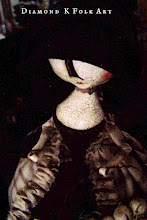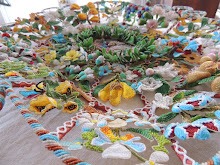Responsibilities of Collecting Part 2 of 2
So what CAN you do to help protect and preserve your textiles?
A person need not make a million dollars or have a Masters degree in textile conservation to do these few really simple things, to help keep our cherished textile collections lasting way past our own lifetimes.
Keeping our areas clean is a start. Vacuum and inspect both display and storage areas ON A REGULAR BASIS. UV light can be filtered quite easily actually~ and you don't have to out and buy those horrible light blocking sunshades and live in a dark cave. I have all of my windows covered with a clear UV blocking film~ it can be bought by the roll, and easily applied. I got mine from University Archival Products, and it is relatively inexpensive, and blocks 80% of the UV. You can't even tell its on the windows. You can also buy UV free light bulbs that fit in both regular sockets, and those for spot & flood lamps. University carries a line of UV filters that actually fit over long fluorescent light bulbs that block all the UV emitted from them...you can get a pack of 6 for less than a single UV filtered fluorescent bulb, and they last indefinitely, and can be taken off and switched to a new bulb when that one burns out.
So where should you store your textiles if not in Grandmas old cedar chest???
I always recommend flat storage for any textile, over being hung. Quilts should always be ROLLED, and never folded. Acid free storage boxes are readily available, but they are quite expensive, and will still need to be changed out when they are no longer inert. Same thing with tissue~ you want to pad your garments and flat folds to avoid creasing, and acid free tissue is easy to find~ but good grief! EXPENSIVE! The reason we want to store things in an acid free environment is that acids leach out of products, and can alter the fibers, they can stain and burn fabrics, leaving holes and marks that are irremovable. Have you ever seen an old illustrated book, that the page opposite the illustration has a shadow of the image? That is from the acids in the paper and ink~ the same things will happen to clothing and quilts and blankets~ any textile. Acid free products are not acid free forever~ they all will eventually absorb the acids from the environment and need to be changed~normally at least once a year~ sometimes more often. Of coarse the acid free cardboard boxes are ideal, but if you cannot afford them, the next best thing is to use a cardboard box, and line this with an old cotton sheet, or unbleached muslin that has been washed several times. You can spend around 30 dollars for a tiny roll of acid free tissue, or trek down to your grocery store and spend around 4.00 for the same equivalent, but in paper towel form~ its true!!!! Trust me, I have acid testers, and BOUNTY MICROWAVE PAPER TOWELS are ACID FREE. You have to get the microwave kind, as their other types and printed ones are acidic. I don't use the one at the very first, or end of the roll, that have the glue on them from being attached to the roll. Pad the your hearts content with them, your pocket book and textiles will love you for it :) You should inspect your storage containers at least once a year for any sign of insects, moisture, and at that time, repack with new acid free papers.
When handling your garments and such, do wash your hands with plain soap and water beforehand. Do not use lotions or powders on your hands, or perfumed soaps to wash with, as these will all leave residues behind that can show up as a stain on the fabric over time. Some use white gloves, myself included, when handling their textiles, but one must be very careful to change them out at the first sight of grubbiness~ they pick up a lot of dirt over a day of use, and also will deposit that dirt between the textiles they are meant to be protecting. If you have textiles with metal lace or trims, be particularly careful to not touch these with naked hands, as you could leave finger acid stains on them. Every ones skin chemistry is different, so it is easiest to avoid touching these areas all together.
I feel that if we have chosen to be the keepers of these special artifacts, it is our responsibility to keep them in a safe environment~ its not hard, and once you know what to look for, and how to handle them properly, as fragile as they are, your treasures should enjoy a safe lifetime with you, and be just as nice and in as good of condition when you pass them on.
Thursday, September 30, 2010
Subscribe to:
Post Comments (Atom)







No comments:
Post a Comment